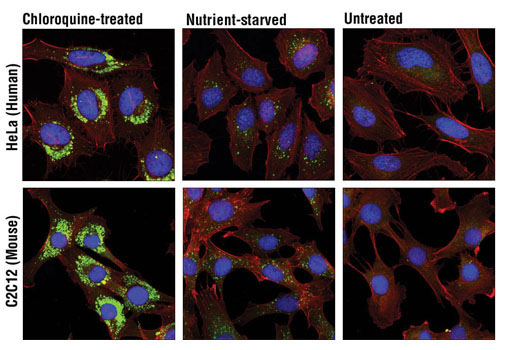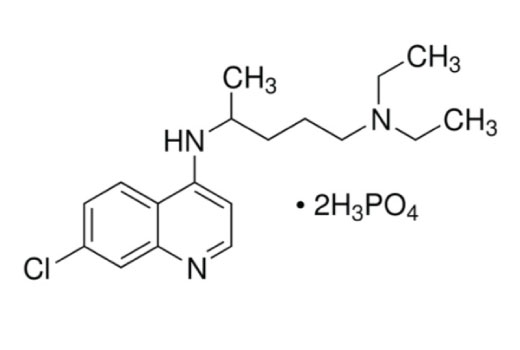Background
Chloroquine (CQ) is a lysosomotropic agent with an extensive range of biological effects (1). Historically known for its anti-malarial activity, chloroquine is a widely used biological research tool for studying autophagy inhibition. Research studies demonstrate that chloroquine accumulates in acidic lysosomes and increases the lysosomal pH. This inhibits lysosomal hydrolases and prevents autophagosomal fusion and degradation, which can result in apoptotic or necrotic cell death (1-4). Inhibition of chloroquine-induced apoptosis with the V-ATPase inhibitor bafilomycin A1 has been observed in several cell types (4). Chloroquine also enhances the anti-neoplastic effects of the histone deacetylase inhibitor vorinostat (SAHA) (5).
Chloroquine treatment of cells leads to accumulation of light chain 3-II (LC3-II) (1-3). This autophagy marker resides within autophagosomal membranes during the autophagic process and is degraded upon fusion with lysosomes. Chloroquine inhibition of these fusion events effectively blocks LC3-II degradation.
This product has applications to SARS-CoV-2 research into the mechanisms of the Novel Coronavirus, which has caused the COVID-19 pandemic.
Molecular Formula
C18H26ClN3•2H3PO4
Molecular Weight
515.9 g/mol
Purity
>98%
CAS
50-63-5
Solubility
Soluble in H2O at 25mg/ml.
Storage
Directions for Use
Chloroquine is supplied as a lyophilized powder. For a 50 mM stock, reconstitute the 150 mg in 5.82 ml sterile dH2O. First add 1 ml dH2O to the tube containing the chemical, vortex, and dispense into a new, larger tube. Repeat this action two or three more times to transfer any residual material. Add additional dH2O to the new tube to bring the volume up to 5.82 ml. Filter sterilize into sterile tube. Utilize a syringe and 0.2 μm syringe filter to minimize sample loss.
Working concentrations and length of treatment can vary depending on the desired effect, but it is typically used at 25-100 μM for 12-48 hr.
Background References
Cross-Reactivity Key
H: human M: mouse R: rat Hm: hamster Mk: monkey Vir: virus Mi: mink C: chicken Dm: D. melanogaster X: Xenopus Z: zebrafish B: bovine Dg: dog Pg: pig Sc: S. cerevisiae Ce: C. elegans Hr: horse GP: Guinea Pig Rab: rabbit All: all species expected
Trademarks and Patents
使用に関する制限
法的な権限を与えられたCSTの担当者が署名した書面によって別途明示的に合意された場合を除き、 CST、その関連会社または代理店が提供する製品には以下の条件が適用されます。お客様が定める条件でここに定められた条件に含まれるものを超えるもの、 または、ここに定められた条件と異なるものは、法的な権限を与えられたCSTの担当者が別途書面にて受諾した場合を除き、拒絶され、 いかなる効力も効果も有しません。
研究専用 (For Research Use Only) またはこれに類似する表示がされた製品は、 いかなる目的についても FDA または外国もしくは国内のその他の規制機関により承認、認可または許可を受けていません。 お客様は製品を診断もしくは治療目的で使用してはならず、また、製品に表示された内容に違反する方法で使用してはなりません。 CST が販売または使用許諾する製品は、エンドユーザーであるお客様に対し、使途を研究および開発のみに限定して提供されるものです。 診断、予防もしくは治療目的で製品を使用することまたは製品を再販売 (単独であるか他の製品等の一部であるかを問いません) もしくはその他の商業的利用の目的で購入することについては、CST から別途許諾を得る必要があります。 お客様は以下の事項を遵守しなければなりません。(a) CST の製品 (単独であるか他の資材と一緒であるかを問いません) を販売、使用許諾、貸与、寄付もしくはその他の態様で第三者に譲渡したり使用させたりしてはなりません。また、商用の製品を製造するために CST の製品を使用してはなりません。(b) 複製、改変、リバースエンジニアリング、逆コンパイル、 分解または他の方法により製品の構造または技術を解明しようとしてはなりません。また、 CST の製品またはサービスと競合する製品またはサービスを開発する目的で CST の製品を使用してはなりません。(c) CST の製品の商標、商号、ロゴ、特許または著作権に関する通知または表示を除去したり改変したりしてはなりません。(d) CST の製品をCST 製品販売条件(CST’s Product Terms of Sale) および該当する書面のみに従って使用しなければなりません。(e) CST の製品に関連してお客様が使用する第三者の製品またはサービスに関する使用許諾条件、 サービス提供条件またはこれに類する合意事項を遵守しなければなりません。


